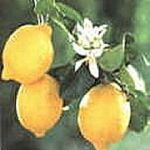| Common Name: |
Citron |
| Botanical Name: |
Citrus medica |
| Genus: |
Citrus |
| Family: |
Rutacea |
| Native Location: |
SW Asia |
| Cultivation: |
Well-drained, neutral to slightly acid soil in sun, with ample moisture during the growing season. Scale insects, mealybugs, and tortrix moth caterpillars may affect plants under cover. Citruses do not transplant well. |
| Propagation: |
By seed sown when ripe or in spring at 16° C (61°F); by semi-ripe cuttings in summer. Cultivars do not come true from seed. |
| Harvest: |
Flowers (C. aurantium, C. bergamia) are picked when first open and distilled for oil. Leaves (C. aurantiifolia, C. hystrix) are picked as required for flavoring and infusions. Oil is distilled from foliage, unripe fruits (C. aurantium) and ripe fruits (C. bergamia). Fruits are picked when unripe or ripe for culinary use, candying, or oil distillation, and either unripe or ripe (C. aurantium, C. reticulata) for use in Chinese medicine. |
| Variations: |
Etrog
Is smaller and less vigorous, with thick-skinned, highly aromatic fruits. 15-25cm (6-10in) long, excellent for candying.
Var. digitata syn. var. sarcodactylis
(Buddha's hand/fingers)
Has strange fruits, wholly or partly divided into finger-like sections, lacking pulp and often seedless. Popular as offering in Buddhist temples, for scenting rooms and clothing. |
| Height: |
3-5m (10-15ft) |
| Width: |
2-3m (6-10ft) |
| Hardiness: |
Min.3-5°C (37-41°F). Sometimes withstands short periods of 0°C (32°F) |
| Parts Used: |
Fruits, peel |
| Properties: |
A highly aromatic herb. |
| Culinary Uses: |
Fruits of 'Etrog' variety are eaten during the Jewish Feast of the Tabernacles. Peel is candied or used in making candy. |
| Bibliography: |
Encyclopedia of Herbs by Deni Brown Copyright © 1995, 2001 Dorling Kindersley Limited Pp 171-173 |
